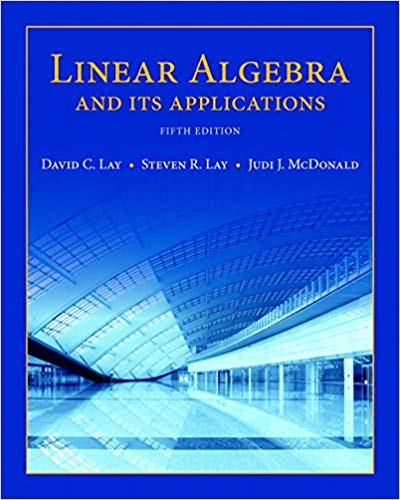
Linear Algebra and Its Applications, 5th Edition
Authors: David C. Lay, Steven R. Lay, Judi J. McDonald
ISBN-13: 978-0321982384
We have solutions for your book!
See our solution for Question 8E from Chapter 4.1 from Lay's Linear Algebra and Its Applications, 5th Edition.
Problem 8E
Chapter:
Problem:
In Exercises 5-8, determine if the given set is a subspace of Pn for an appropriate value of n. Justify your answers. All polynomials in Pn such that...
Step-by-Step Solution
Step 1
Given that ${\bf{p}}\left( t \right)$ is set of polynomials of the form\[{\bf{0}}\left( t \right) = 0\]We need to satisfy following conditions to prove that the given set is a subspace of all polynomials in $P_n$.
(a) The zero vector of V is in $H^2$
(b) H is closed under vector addition. That is, for each u and v in H, the sumu + v is in H.
(c) H is closed under multiplication by scalars. That is, for each u in H and eachscalar c, the vector cu is in H.
Step 2: Condition (a): Property of zero vector
The 0 vector belongs to set V, as\[P\left( 0 \right) = 0\] The first condition is satisfied.
Step 3: Condition (b): Property of vector addition
Let us take two vectors p and q in H:Upon adding the vectors:\[\begin{array}{l}p + q = p\left( 0 \right) + q\left( 0 \right)\\\\ = 0 + 0\\\\ = 0\end{array}\]Since, the addition of the above vectors also lies in H, the closure property of vector addition is satisfied.
Step 4: Condition (c): Property of scalar multiplication
Let, c be an arbitrary scalar and a vector u be $u(0)= 0$, that lies in H.Upon scalar multiplication:\[\begin{array}{*{20}{l}}{u = 0}\\{}\\{cu = c \times 0}\\{}\\{ = 0}\end{array}\]Since, the scalar multiplication also lies in H, the closure property of scalar multiplication is satisfied. Since all three conditions are satisfied, the set H is a subspace of V.
Given that ${\bf{p}}\left( t \right)$ is set of polynomials of the form\[{\bf{0}}\left( t \right) = 0\]We need to satisfy following conditions to prove that the given set is a subspace of all polynomials in $P_n$.
(a) The zero vector of V is in $H^2$
(b) H is closed under vector addition. That is, for each u and v in H, the sumu + v is in H.
(c) H is closed under multiplication by scalars. That is, for each u in H and eachscalar c, the vector cu is in H.
Step 2: Condition (a): Property of zero vector
The 0 vector belongs to set V, as\[P\left( 0 \right) = 0\] The first condition is satisfied.
Step 3: Condition (b): Property of vector addition
Let us take two vectors p and q in H:Upon adding the vectors:\[\begin{array}{l}p + q = p\left( 0 \right) + q\left( 0 \right)\\\\ = 0 + 0\\\\ = 0\end{array}\]Since, the addition of the above vectors also lies in H, the closure property of vector addition is satisfied.
Step 4: Condition (c): Property of scalar multiplication
Let, c be an arbitrary scalar and a vector u be $u(0)= 0$, that lies in H.Upon scalar multiplication:\[\begin{array}{*{20}{l}}{u = 0}\\{}\\{cu = c \times 0}\\{}\\{ = 0}\end{array}\]Since, the scalar multiplication also lies in H, the closure property of scalar multiplication is satisfied. Since all three conditions are satisfied, the set H is a subspace of V.